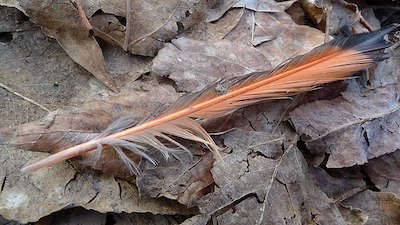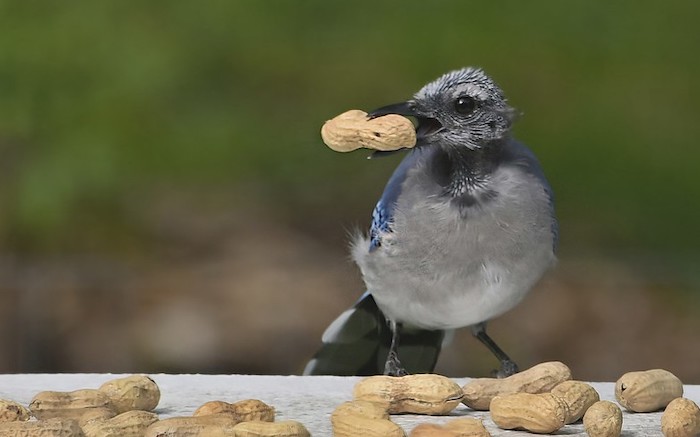Hair is to mammals as feathers are to birds. This analogy might make sense on the SAT exam, but biologically, feathers are a bigger deal than hair. Compare humans and birds. We may be oddballs but we're still mammals. If we lose our hair we might be a little chillier, but bald is beautiful and hair loss doesn't impact our life too much. A bird without feathers, is like a naked human who has also lost their car, bike, feet or other primary means of travel.
Feathers are a defining characteristic of birds. Many reptiles lay eggs like birds, and bats can fly like birds, but only birds have feathers. Feathers literally give birds their wings to fly. And perhaps just as importantly, they help these reptile cousins retain their body heat, even in surprisingly cold environs, and live an active, endothermic (warm-blooded) lifestyle. They're also an essential fashion item; they can provide camouflage or help attract mates.
Feathers are, quite literally, a substantial part of what makes up a bird. Though they may be lightweight, they typically account for 5 to 10% of a bird's weight. The cumulative weight of a bird's feathers is often 2 to 3 times heavier than its skeleton!
While both feathers and hair are made of a protein called keratin, they consist of different forms of keratin. Hair is composed of alpha-keratins, but feathers are made of a harder form called beta-keratin. This makes feathers remarkably durable. But sun, abrasions, and parasites take a toll on feathers and they need to be replaced regularly in order to maintain their function.
This regular replacement of feathers is called molt. This is different from replacing the occasional feather that is lost, say after a close call with a Sharp-shinned Hawk. Lost feathers are replaced right away. Worn, broken or damaged feathers are only replaced via a regular molt. Molt is an essential, but costly, part of the life cycle of a bird.

A Northern Flicker tail feather. Photo by Thayne Tuason.
Replacing feathers requires a lot of energy. Since feathers are made out of protein, birds must convert protein in their diet or from their muscles to build new feathers. Annual molt can require a quarter or more of a bird’s total body protein mass, much of which comes from muscle tissue.
There are also indirect energetic costs associated with molting. Fewer feathers means reduced insulation and the loss of more body heat. Also, developing feathers, called pin feathers, are still living tissue and filled with blood vessels. Exposing those blood vessels near the surface of the body causes additional heat loss.
Lost flight feathers mean less efficient flight, another indirect cost. Many waterbirds even lose the ability to fly altogether during molt because they replace all their wing feathers at once. Thankfully they evade many predators by diving or by amassing into large flightless flocks.
Molt is also behaviorally demanding. Less efficient flight means birds may be more vulnerable to predators. Plus, the high energy demands of molt make it incompatible with other energetically demanding activities like breeding or migration. For adults, molt is a time to lay low, eat, and relax after breeding.
Molt is so demanding that some species actually migrate to different habitat to undergo the process- this is called "molt migration." Traditionally, many songbirds were thought to molt on their breeding grounds, prior to migration. And for many years, the phenomenon of molt migration was thought to occur in just a handful of species. But in 2018, IBP scientists found evidence that molt migration is more common than previously thought. Using data from the MAPS program, they looked at the probability of catching a bird undergoing molt at the same banding station that it was captured in breeding condition.
They found evidence that most North American landbirds can migrate or disperse to areas separate from the breeding or wintering grounds to molt. These included species like American Goldfinch, House, Carolina and Pacific Wrens, Gray Catbirds and Northern Cardinals. These are not merely "pit stops" on the way to the wintering grounds but include layovers of six weeks or more to undergo a complete molt of feathers, before moving on to winter grounds. Some species moved East or West, up to higher elevation or down to lower elevation. But most species head south, at least on their way to winter grounds.
Why move to molt? The most likely explanation is food resources (although this hypothesis has not yet been tested scientifically.) Birds breed in areas where food is abundant early in the summer, when they are courting, laying eggs and feeding chicks. Towards the end of the summer, food resources (like insects) may decrease in these habitats, but increase in others.
This is most evident in western North America, where conditions become drier in most areas in late summer but wetter down in the Mexican Monsoon Region of the Southwest. As documented by IBP research in 2009 and 2011, a host of molt-migrant species go to this monsoonal region to take advantage of a late summer flush of vegetation and insects, in an area where fewer birds breed due to hot and dry conditions in spring and early summer. Birds are very mobile creatures, so they can move to areas, in any and all directions, where there is plenty of food to grow new feathers.
Molt clearly matters to birds. In our next blog post, we'll look at what bird banders and scientists can learn when they pay attention to molt.
Note: If you would like a pdf version of this post formatted for printing, you can request one via email from Meredith: mswalker@birdpop.org.






